
Guide
How to clean your office chair properly
by Raphael Knecht

Whether you use a dishwasher or not, washing up is tedious enough. But getting wine glasses spotless is a whole other story. The right techniques and tools are what make the difference.
As a clean freak, I can't think of anything worse than wine glasses all bunged together, stewing in their own red juice and vegetating in front of my very eyes. Just seeing them languish like inglorious trophies, waiting for a long overdue wash. Even if you pour out any wine left in the glass and rinse it, there's still going to be a bit left. For clean freaks, the pièce de résistance is still being able to see marks from the last careless wash. If you don't have a dishwasher, there are a few tricks and kitchen gadgets that help lend a new shine to your glasses without breaking them. But even if you do have a dishwasher, there are some dos and don'ts for giving your wine glasses a spotless, shard-free lease of life.
First things first: use a dishwasher if you have one. Even delicate and expensive wine glasses break less easily in the dishwasher than if you hand wash them. Manufacturers of these kinds of glasses also recommend putting them in the dishwasher. Modern appliances in particular have special wash cycles for wine glasses and other delicate glassware. Dishwashers get a helping hand from detergent that's been designed specifically for handling wine residue and getting rid of water residue.
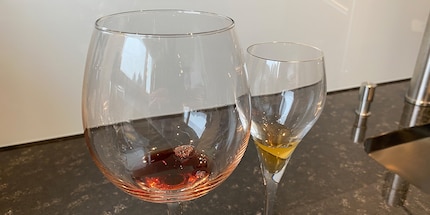
I should point out that you can use a lot of the tips and tricks below on other types of glassware as well. You'll want to be more careful depending on the quality, shape and thickness of the glass. For instance, tall, slender glasses will break if you try to shove too thick a glass brush in them. You also have to be careful with printed, engraved or coloured glass. To avoid any damage, try detergent, brushes or cloths on the foot of the glass first – or another inconspicuous place. An important point that applies to all types of glass is: always follow the manufacturer's care instructions first, if they come with the product or if you can find them online. You should only take my tips and tricks to heart if you can't get your hands on official instructions.
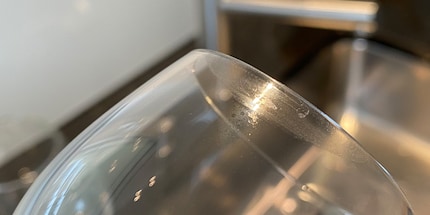
If you have a dishwasher, then you'll need the right dishwasher detergent. If you want your wine glasses to look like new for as long as possible, make sure you buy the detergent in measured-out form. It doesn't matter if it's a liquid or a powder. Just avoid tablets where possible. Because too high a dose can attack the surface of the glass and damage it in the long run. You should also use rinse gloss. That's actually a good tip for every wash cycle, but especially for wine glasses that are very important to you. It ensures the glasses come out of the dishwasher without any water spots or any other marks. If your dishwasher detergent already contains rinse gloss, you don't need to add any extra.
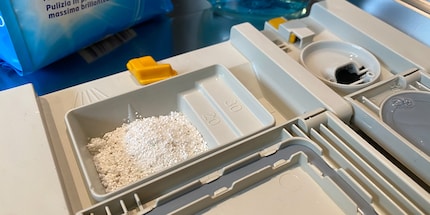
I also recommend getting a bottle brush. Even though these are actually designed for cleaning bottles, they work wonders on wine glasses. They're especially handy if you don't have a dishwasher. In that case, you'll also need washing-up liquid for hand washing. Using an unscented detergent means there's no risk that the next sip of wine from your supposedly clean glass will smell of soap. To get rid of any streaks once you've washed them, I recommend polishing them with a microfibre cloth. This removes marks better than traditional cotton cloths and doesn't leave any fluff. To remove stubborn stains when washing by hand, it also helps to hold glasses upside down over a pan of hot water so the steam softens any dirt.
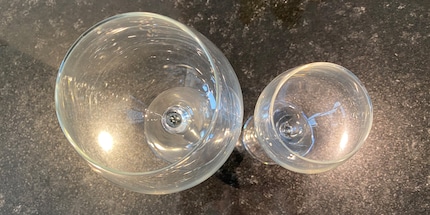
With a dishwasher, it's relatively easy to work out how long you'll need. In theory, at least as long as the wash cycle. Plus a few minutes before for loading the machine, a few minutes after for emptying it and then a few minutes for wiping the glasses dry with a microfibre cloth. As for washing by hand, you'll need to factor in five to ten minutes per glass for a proper clean, including steaming, deep cleaning and wiping dry. It depends how meticulous you are with each glass. It's best to budget too much time rather than too little. That way you reduce the risk of breaking glasses.
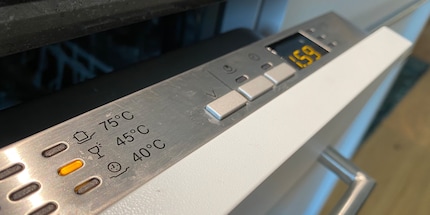
When washing glasses in the dishwasher, put them in the top rack if there is one. Most dishwashers have special glass holders. When you're loading the dishwasher, make sure the glasses aren't touching each other. You don't want them to be in contact with any cutlery or dishes either to avoid scratches or anything worse. You also want to make sure the glasses are in the rack properly, that way they can't fall out of the holder or tip over. Thicker, more stable glasses can be stored in the lower rack if necessary. In some dishwashers, you can alter the height of the top rack to fit more glasses in.
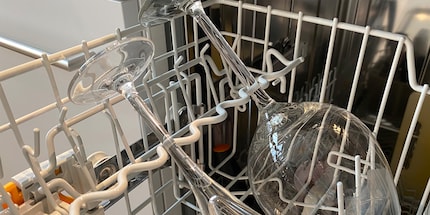
Where possible, use a detergent with enzymes, as it's more effective at getting rid of food and drink residue. It's especially important when you're washing glasses with cutlery and tableware. You can also add rinse gloss if this isn't already in the detergent. If you're only washing wine glasses in the dishwasher with other glasses, I'd suggest using a more gentle detergent. Otherwise, you can end up with soap marks and over time, the surface of the glass will get damaged.
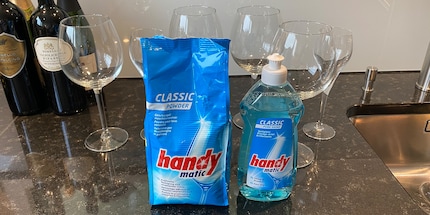
Reduce the amount of detergent if you're only washing glasses. If your glasses smell soapy when you've finished washing them or next have a sip of wine, you've used too much dishwasher detergent. What also plays a part is water hardness and how dirty the glasses are. The softer the water and cleaner the tableware, the less detergent you'll need. If the glasses still don't come out the way you'd like them, check the dishwasher filter. Does the water run all the way through it, is it blocked or even damaged? Try running the machine again with a different detergent if none of the tips above make a difference.
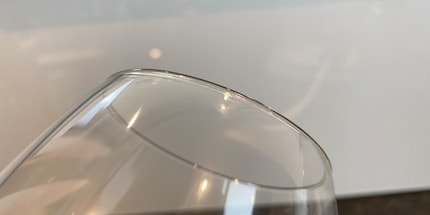
One of the reasons wine glasses are so prone to break – aside from them falling on the floor – is people don't know how to wash them by hand properly. A delicate wine glass that you're touching with wet hands is almost predestined to slip through your fingers and come back down to earth with a bang... or a crash. It's also easy for your mind to wander for a moment and then realise that the foot or bowl of your glass is hitting the sink. What's more, the delicate stem will break if you're too rough when trying to clean it. That's why I highly recommend the bottle brush idea. That way you don't have to turn, rotate or scrub the glass as much. And you'll be less likely to end up with a heap of shards.
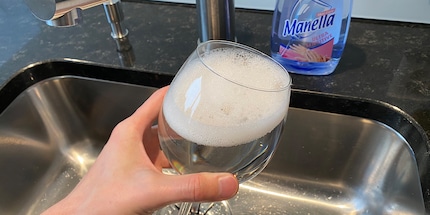
If you don't have a dishwasher and have to wash your wine glasses by hand, there are a few other pointers you should be aware of. For one, always hold the glass by the stem – but use your entire hand and not just two fingers. Then clean the inside of the glass carefully, using a bottle brush, warm water and washing-up liquid. You can wash the outside of the glass either with a damp cloth or by holding it under running water. After that, rinse the wine glass from top to bottom with warm water until there aren't any soap suds left. Finish up by wiping the glass dry with a microfibre cloth. You need to be careful at all stages of the process, and make sure you don't leave too long between washing and drying, otherwise you'll end up with water spots.
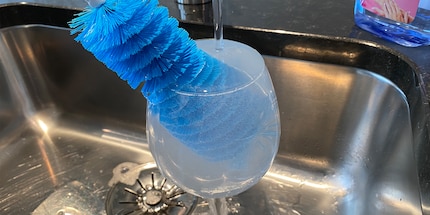
It doesn't matter if you wash your wine glasses by hand or in the machine, you still have to polish them before putting them back in the cupboard or display case. This removes the last fingerprints and any remaining water spots. You'll want to use the largest microfibre cloth you've got. But make sure you reserve this cloth for polishing glass. That way you avoid transferring any dirt or allowing other small particles to stick to the glass, smear or even scratch it. In addition, you never want to wash the microfibre cloth with fabric softener, as this damages the cloth and leaves smear marks on the glass. You can remove any stubborn marks on and in the glass with the help of steam. Hold the glass over the spout of a filled kettle, a pan of boiling water or a cup of hot water. As soon as the glass starts to steam up, you can wipe it dry carefully with a microfibre cloth.
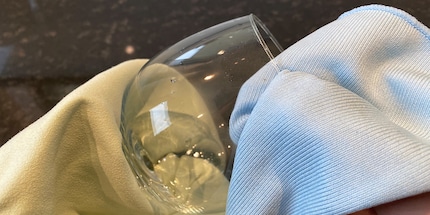
Always pay attention to the part of the glass you're cleaning and apply the right pressure there. The rim and stem are particularly tricky, especially on delicate glass. First wrap the foot of the glass in a microfibre cloth and polish this part of the wine glass with both hands. Keeping one hand on the microfibre cloth on the foot to steady the glass, take a corner of the cloth with the other hand – or better still, a second cloth – and wipe the stem. Then, use the microfibre cloth to hold the bowl of the glass with one hand as you polish the inside and outside of the wine glass with the other. If you follow all these tips, your wine glasses will sparkle like the sun without a spot or streak in sight – even after loads of washes.
When I'm not stuffing my face with sweets, you'll catch me running around in the gym hall. I’m a passionate floorball player and coach. On rainy days, I tinker with my homebuilt PCs, robots or other gadgets. Music is always my trusted companion. I also enjoy tackling hilly terrain on my road bike and criss-crossing the country on my cross-country skis.
Practical solutions for everyday problems with technology, household hacks and much more.
Show all